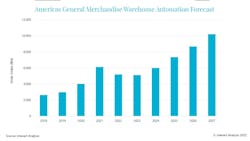The warehouse automation market grew by 28% in 2021, with revenues reaching $36 billion, up from $28.5 billion in 2020, according to a report from Interact Analysis.
The company points out that this growth was driven mainly as a result of the e-commerce spike caused by the pandemic. According to FRED, US E-commerce penetration peaked at 16.4% in 2020, rising from 10% in Q1 2019.
To serve this market, many retailers increased their fulfillment capacity with Amazon increasing total warehouse square footage to 525 million by the end of 2021, compared to the 272 million square footage it had in 2019.
With larger large warehouses comes increased automation. Again looking at Amazon as a bellwether for the industry, this one company's automation investments accounted for more than 30% of the total automation investments in the US in 2021, according to Rowan Stott, an analyst with Interact Analysis, in an article on the company's website.
Another effect of the pandemic, whose early lockdowns resulted in many companies having artificially low revenues in 2020, was project completion dates were pushed back into 2021, Stott points out.
Will Growth Last?
Since its peak of 16.4%, US e-commerce penetration dropped slightly in 2021, largely due to a shift back to brick-and-mortar retail which is going through somewhat of a renaissance. In response to slowing e-commerce sales, many e-commerce retailers announced a pullback in their fulfillment network expansions.
For example, Amazon announced it would be slowing down its fulfillment expansion after posting a loss in Q1 2022. This will have a significant impact on its investments in warehouse automation which we expect will be cut by 30% in 2022 with a further 15% reduction in 2023. This will have a significant impact on the overall warehouse automation market, says Stott.
Other factors including geopolitical and economic factors such as the Russia-Ukraine war have led to a rise in economic uncertainty in Europe as well as soaring energy prices, says Stott. This is causing some retailers and manufacturers to postpone large capital investments notes Stott.
"Furthermore, we’ve also seen many central banks raise interest rates in order to tackle high inflation. This will increase the cost of capital and may result in companies looking to postpone investments in automation financed using debt. High-interest rates, inflation and low consumer confidence will also slow retail growth and reduce appetite for warehouse automation," says Stott.
Looking at 2024 and beyond, Stott says to expect a return to steady growth. Interact Analysis' Warehouse Building Stock Database shows that 18% of warehouses have some type of automation and that's expected to grow by 26% by 2027. "With such a large opportunity, short-term challenges shouldn't take away from the long-term growth potential this market faces," says Stott.
Between 2024 and 2027, Interact Analysis forecasts revenues to grow at a CAGR of 19%, driven by improving macroeconomic conditions. "From 2024 onwards, we expect e-commerce growth will pick up as the geopolitical and economic environment strengthens. Furthermore, as economic conditions improve, we expect a renewed focus on shorter delivery windows from consumers which hasn’t been a top priority in recent months due to the cost of living crisis in many countries," says Stott.

